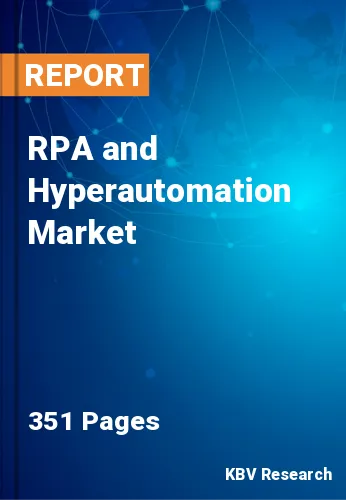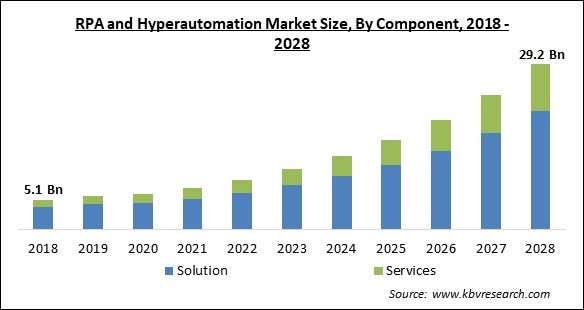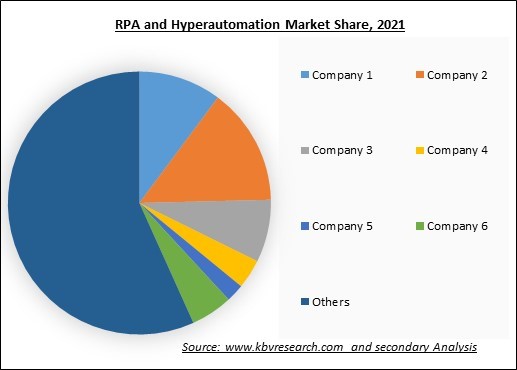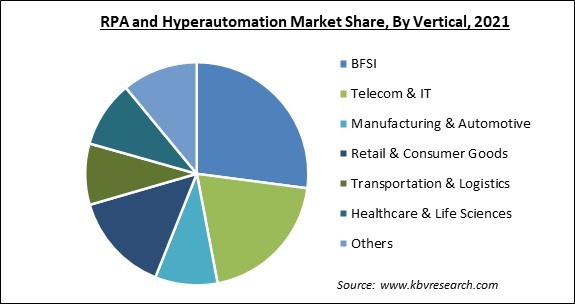
The Global RPA and Hyperautomation Market size is expected to reach $29.2 billion by 2028, rising at a market growth of 22.2% CAGR during the forecast period.
Hyperautomation provides automation for nearly any repetitive action performed by business users by combining AI tools with RPA (Robotic Process Automation). It even optimizes the automation by finding business processes dynamically and creating bots to automate them. In addition, hyperautomation is a mechanism for true digital transformation, with tools like Robotic Process Automation (RPA), artificial intelligence (AI), and machine learning (ML) working together to automate complicated business processes comprising where subject matter professionals were once necessary.

Combining RPA and AI technology gives the organizations the power and agility to automate operations that were previously impossible to automate, such as undocumented activities with unstructured data inputs. RPA+AI are the crucial ingredients of hyperautomation, as AI distinguishes Digital Workers from traditional automation methodologies.
This helps businesses to quickly respond to client expectations, achieve corporate objectives, increase productivity, and boost efficiency. Pure RPA bots, for example, can only read standardized and digitized invoices and documents. When OCR and NLP are combined with RPA, hyperautomated robots may do time-consuming yet intuitive activities like sales reports, contracts, and scanning bills, emails, or formal documents from numerous vendors in various formats. They can also hear, read, and converse at breakneck speed to assist in responding to and identifying opportunities.
By boosting customer on-boarding, reducing compliance processes, and enhancing precision and speed, financial institutions may improve the operations and remain competitive. A corporation must discover ways to adjust its operations to meet customer problems and improve the customer experience as customer expectations and needs change. Customer service processes and technologies that incorporate hyperautomation can eliminate manual duties, categorize inquiries, give quick solutions, and simplify workflows.
Process discovery utilizes AI to unveil processes and develop bots automatically, speeding up the automation process by up to 5 times. Automation ground-breaking architecture allows business stakeholders to participate at every stage of the process automation journey. Business leaders, process analysts, technological specialists, and knowledge workers may grow automation to unprecedented levels while preserving stringent governance and data protection. Hyperautomation analytics are created using the data that bots acquire while they work.
The outbreak of the COVID-19 pandemic has led to the digital transformation process into disarray. For an extended period of time, executives were not prepared for an overnight transformation to 100 percent digital operations. Remote work, security, e-commerce, supply chain, and business processes and software were all vulnerable to crushing expectations, bottlenecks, and points of failure across the organization. Business continuity and stability became everyone's top priority all of a sudden. COVID-19 drove old processes and BPOs well past peak capacity, which was both obvious and unanticipated.
Technology is progressing, and every industry is attempting to keep up with the changes. Hyperautomation assists businesses in detecting safety infractions before they become accidents or liabilities. Also, hyperautomation also ensures that onsite workers are following pedestrian walking lanes accurately, validates the security of safety equipment and that it is being worn at all times. It also provides real-time data of job-site behavior so that changes can be made based on data rather than guesswork, and thus integration and widespread acceptance of automation in the building projects, as well as other industries, are likely to bring opportunity for hyperautomation.

The leading players in the market are competing with diverse innovative offerings to remain competitive in the market. The below illustration shows the percentage of revenue shared by some of the leading companies in the market. The leading players of the market are adopting various strategies in order to cater demand coming from the different industries. The key developmental strategies in the market are Product Launches.
Hyperautomation is a true digital transformation that uses sophisticated technologies. It automates complex business procedures, even when subject matter experts were formerly required. This is an extension of typical business-process automation methods. Hyperautomation, which combines AI and RPA, enables robots to do digital tasks that would normally be performed by humans. With the advancement of automation technologies, hyperautomation is becoming more prevalent. People-centred and smart working environments are becoming more common in businesses. There are various firms that dedicatedly work for different industries to incorporate automation in the business processes.
Large enterprises frequently discover that the objectives are mismatched with enterprise restrictions and insight into crucial business operations after integrating the digital workforce. Automated business processes that are linked to changing touch-points, controls, or decisions must be taken out of production, re-analyzed, and then updated before being re-implemented. This whole process is very timely as well as resource-consuming. It involves the requirement of a skilled and competent workforce to match the aim of business with the business process, but there is still a scarcity of quality workforce.
Based on Vertical, the market is segmented into BFSI, Telecom & IT, Manufacturing & Automotive, Retail & Consumer Goods, Transportation & Logistics, Healthcare & Life Sciences, and Others. The Manufacturing & Automotive segment garnered a significant revenue share in the RPA and Hyperautomation market in 2021. Manufacturers are seeking to automation and Industry 4.0 technologies to boost the efficiency as a result of the ongoing need to generate throughput and save expenses. Automation is now more commonly understood as the use of machines to lessen human labor. It is now often related to electro-mechanical systems that may be programmed to carry out a variety of tasks.

Based on Component, the market is segmented into Solution and Services. The Solution segment acquired the highest revenue share in the RPA and Hyperautomation market in 2021. It is because these solutions enhance operational efficiency and reduce human labor processes with RPA and hyperautomation solutions. The application of AI and associated developing technologies to robotic process automation, such as computer vision, cognitive automation, and machine learning, is known as RPA and Hyperautomation.
Based on Deployment Mode, the market is segmented into Cloud and On-premise. The cloud segment garnered the maximum revenue share in the RPA and Hyperautomation Market in 2021. This is owing to simplified distributed energy resource management, improved outage management, and ease in complicated device unification. The cloud is best suited to maintain an advanced software for any type of objective.
Based on Deployment Type, the market is segmented into On-premise and Cloud. The Cloud segment witnessed a significant revenue share in the RPA and Hyperautomation market in 2021. Companies are increasingly turning to cloud deployment because of its numerous advantages, including cheaper costs, no need for staff for hardware maintenance, faster and more efficient outcomes, and comprehensive flexibility and scalability, all of which result in lower OPEX and CAPEX.
Based on Organization Size, the market is segmented into Large Enterprises and Small & Medium Enterprises. The large enterprises segment the largest revenue share in the RPA and Hyperautomation market in 2021. It is owing to the greater preference of the large enterprises towards automating various business procedures. In addition, large enterprises implement RPA to boost the speed of their production in order to generate more revenue with better efficiency.
Based on Business Function, the market is segmented into Information Technology (IT), Sales & Marketing, Finance & Accounting, Human Resources (HR), and Supply Chain & Operations. The Sales & Marketing segment witnessed a promising revenue share in the RPA and Hyperautomation market in 2021. When businesses use hyperautomation in marketing and sales, it can optimize a prospect's complete journey by enabling an automated ecosystem to assist management in finding a product/service, resolving questions, placing orders, and receiving post-sales services.
| Report Attribute | Details |
|---|---|
| Market size value in 2021 | USD 7.3 Billion |
| Market size forecast in 2028 | USD 29.2 Billion |
| Base Year | 2021 |
| Historical Period | 2018 to 2020 |
| Forecast Period | 2022 to 2028 |
| Revenue Growth Rate | CAGR of 22.2% from 2022 to 2028 |
| Number of Pages | 369 |
| Number of Tables | 564 |
| Report coverage | Market Trends, Revenue Estimation and Forecast, Market Share Analysis, Segmentation Analysis, Regional and Country Breakdown, Competitive Landscape, Companies Strategic Developments, Company Profiling |
| Segments covered | Component, Deployment Type, Organization Size, Business Function, Vertical, Region |
| Country scope | US, Canada, Mexico, Germany, UK, France, Russia, Spain, Italy, China, Japan, India, South Korea, Singapore, Malaysia, Brazil, Argentina, UAE, Saudi Arabia, South Africa, Nigeria |
| Growth Drivers |
|
| Restraints |
|
Based on Regions, the market is segmented into North America, Europe, Asia Pacific, and Latin America, Middle East & Africa. Asia Pacific garnered a significant revenue share in the RPA and Hyperautomation market in 2021. The primary nations driving the RPA and Hyperautomation market in APAC are China, Japan, and India. In this region, SMEs and major corporations have become more cognizant of government rules and compliances, and have begun to deploy RPA and Hyperautomation technologies proactively. The acceptance of AI technology by many verticals, such as BFSI, manufacturing, and retail, is likely to fuel the RPA and Hyperautomation market's rapid expansion.

Free Valuable Insights: Global RPA and Hyperautomation Market size to reach USD 29.2 Billion by 2028
The major strategies followed by the market participants are Product Launches. Based on the Analysis presented in the Cardinal matrix; Microsoft Corporation is the forerunners in the RPA and Hyperautomation Market. Companies such as IBM Corporation, SAP SE, Juniper Networks, Inc. are some of the key innovators in the Market.
The market research report covers the analysis of key stake holders of the market. Key companies profiled in the report include IBM Corporation, Microsoft Corporation, SAP SE, Alteryx, Inc., Nice Ltd., Juniper Networks, Inc., Pegasystems, Inc., Appian Corporation, UiPath, Inc., and HelpSystems, LLC.
By Vertical
By Component
By Deployment Type
By Organization Size
By Business Function
By Geography
The global RPA and Hyperautomation market size is expected to reach $29.2 billion by 2028.
The rise in the need for automation within major industries are driving the market in coming years, however, The problem in accounting for regulatory and firm limitations limited the growth of the market.
IBM Corporation, Microsoft Corporation, SAP SE, Alteryx, Inc., Nice Ltd., Juniper Networks, Inc., Pegasystems, Inc., Appian Corporation, UiPath, Inc., and HelpSystems, LLC.
The BFSI segment acquired maximum revenue share in the Global RPA and Hyperautomation Market by Vertical in 2021, thereby, achieving a market value of $7.05 Billion by 2028.
The On-premise segment is leading the Global RPA and Hyperautomation Market by Deployment Type in 2021, thereby, achieving a market value of $15.9 Billion by 2028.
The Information Technology (IT) segment dominated the Global RPA and Hyperautomation Market by Business Function in 2021, thereby, achieving a market value of $9.50 Billion by 2028.
Our team of dedicated experts can provide you with attractive expansion opportunities for your business.
